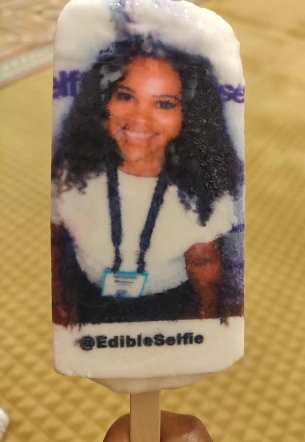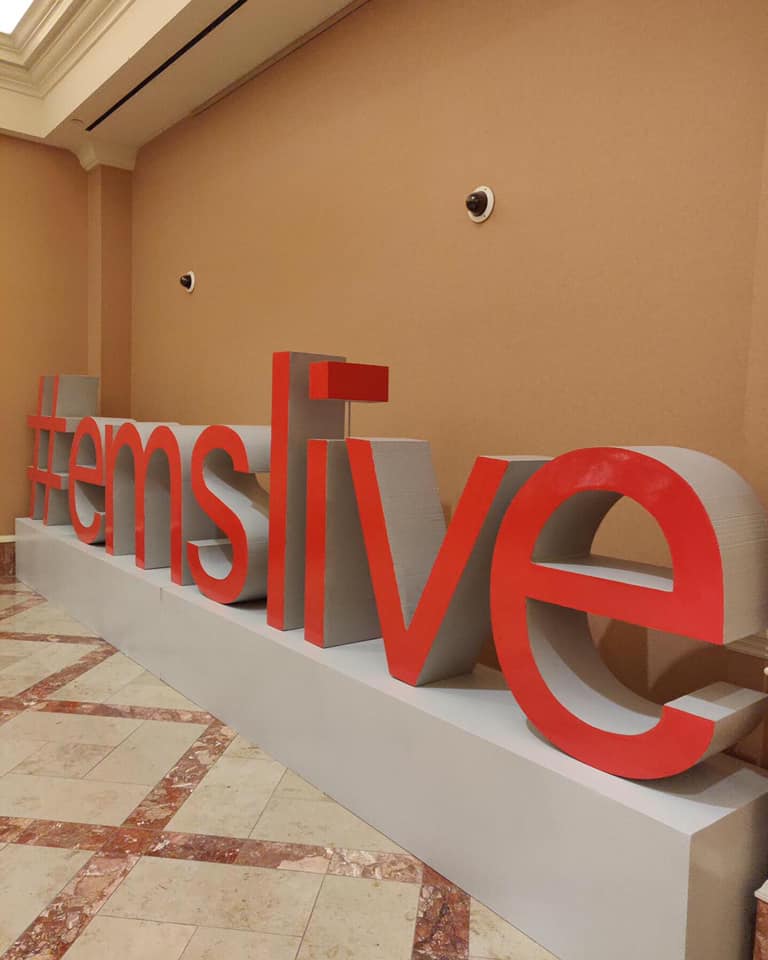What happens in Vegas… gets reported back to the entire team. Earlier this summer, we sent two of our best and brightest to the 2019 Experiential Marketing Summit held in, you guessed it, Las Vegas.
Dianne and Melissa sunk their teeth into the experience—literally, they munched on edible selfies. They also lapped up loads of valuable information on where experiential, and the marketing industry writ large, are headed. Having documented some of the most buzzed about ideas, Melissa and Dianne decided on the six most impressive trends and takeaways they experienced at EMS 2019.
Food, glorious food

Who came for the snacks? You, too? At the Experiential Marketing Summit, some of the treats on display had us seeing double. Did you know it is now possible to print your face on food? Modeled off the good ol’ fashioned photo booth, the technology produces a high-quality, edible image using food inks. You can have your mug in your coffee mug or get some sugar from yourself in marshmallow form.
While the eat-your-selfie experience created a lot of buzz, we saw broad implications for edible printing. Brands, too, can take advantage of the technology—affixing their logo to audience- and experience-appropriate foods.
Augmented everything
If you’re beginning to feel like augmented and virtual reality are synonymous with experiential marketing, you’re not alone. The advancement and affordability of these technologies have put them within reach of more brands than ever before. But make no mistake, AR and VR should enhance, not encompass, a customer engagement.
Two uses of augmented reality, in particular, stood out at the Experiential Marketing Summit: virtual fitting rooms and AR face painting.
Once limited to online eyeglasses try-ons, virtual fitting rooms have expanded to jewelry, cosmetics and clothing. Big names like Amazon, Gap, Sephora and L’Oreal have already introduced the technology. And just as other AR capabilities have become more ubiquitous, we see expansion on the horizon for virtual fitting rooms. Imagine the possibilities at live events! No more trying on a piece of merchandise over your outfit.
Further upping the fun factor, we discovered augmented reality face painting. This technology lets kids of all ages experience the youthful joy of face paint without any clogged pores. NFL teams have already put it to use. Because it gives people the chance to express themselves and show their affinities, AR face painting presents huge organic social sharing potential – a measure of experiential success.
Gamification goes phygital
If you’ve ever searched online for a city’s top attractions, there’s a good chance an escape room made the list. Who wants to voluntarily lock themselves in a room with a captive zombie trying to break free from its chains? Seemingly, everyone… The adrenaline-inducing, super-sleuthing, problem-solving playgrounds are everywhere. And as with all industries, greater saturation brings greater competition. To stay ahead, escape room producers are turning to virtual reality. VR, integrated with live action, creates an enhanced, fully-immersive, multiplayer experience. We expect it won’t be long before virtual reality brings the escape room to the escapee.
Maybe one new escape room theme will be based on evading evil avatars? We think so given the rise of the graphical representations. Avatars exist at the intersection of selfie culture, the desire for personalization, artificial intelligence, and apprehension around human recognition technology. By turning ourselves into cartoons, we free ourselves from having our exact likeness broadcast across the internet, yet we can attribute our likes, dislikes, wants and preferences to a custom, digital version of ourselves.
That got pretty existential pretty quickly. The point is that the use of avatars is growing. The animated figures that got their start in gaming have now entered new arenas like healthcare and education.
Measuring up on ROI

Experiential has long faced criticism for being difficult to measure. And the industry has had enough. Throughout EMS 2019, we connected with agencies and clients serious on how to best evaluate the return on investment (ROI) of experiences. We have proprietary method for ensuring our clients achieve their goals, but found one conversation particularly beneficial when thinking about reporting to clients.
In his presentation, Ben Gross of Jack Morton Worldwide stressed that not all outcomes should be treated equally. He broke down measurement into three types: ROI, key performance indicators (KPIs), and insights. Each, he suggested, is most valuable to select functions within a team.
- ROI maps budget to business value delivered. This information is of greatest benefit to C-suite executives and other big decision makers.
- KPIs contribute to the success and optimization engine. Changing a KPI changes what success looks like. Directors of Marketing or Heads of Events need these details most.
- Insights, meanwhile, provide context for future planning. Insights are most valuable to the everyday actors, likely the individuals responsible for shaping and executing an engagement.
Perhaps Ben’s goal was to prevent his audience from oversharing with (and overwhelming) decision makers. If so, mission accomplished. We agree that different team members get what they most need from different metrics. Just make sure all parties can access any additional information they need.
The difference between diversity and inclusion
Hats off to Kati Quigley of Microsoft for making it clear from the minute she stepped on stage: diversity and inclusion are not the same! Indeed, inclusion is a practice that promotes diversity: a truth that needs to be emphasized and discussed across industry wide.
So how can we foster a positive, inclusive culture? Kati suggested a number of practices that have proved valuable at Microsoft. One simple task is having employees create an “About Me” slide that defines their career, life, and values. The slides can help existing teams get to know each other better as well as introduce new employees to the fold.
One of Microsoft’s tenants that really resonated with us was “be aware of the invisible.” This thinking influences their hiring process, making modifications for disabilities and limitations both seen and unseen. We think it should also apply to diversity of experience. Too often hiring in the marketing industry follows a linear path—Assistant Account Executive to Account Executive, Account Executive to Account Manager, Account Manager to Account Director, and so on. Why not evaluate candidates based on their potential, drive and resilience instead of agency experience, title, and teachable skills?
Culture over everything
Management guru Peter Drucker is quoted as saying, “Culture eats strategy for breakfast.” His words have undoubtedly penetrated the ethos of the presenters at EMS 2019. Nearly every speaker mapped success back to a culture that encourages collaboration, innovation, experimentation, risk taking, experiencing failure, and putting people first.
Take Zappos, for example—our favorite presentation of the week and a long recognized customer service leader. Zappos attributes a lot of its success to workplace culture. Rumor has it that when interviewing with the company, candidates are evaluated on your interactions with everyone, including the parking lot attendant. And once hired, you start on the phones—speaking directly with consumers. The constant challenge for every employee is to consider new ways to continue improving service. What would change if your company approached customer experience that same way?
From lofty “moonshot thinking” to firm “oars in the water,” EMS 2019 was evidence of a collective shift in thinking about workplace culture. Within the strongest organizations, the culture and the brand evolve side-by-side.
To conclude
Consumers say that events and experiences are more effective than retail stores and online advertising in helping them get to know a product. Brands know it, too. The challenge for marketers of all stripes is balancing the allure of innovation (edible selfies, augmented reality and avatars) with meaningful connection (inclusivity, empathy and quality service). We saw both in action at EMS 2019.
Did you attend the 2019 Experiential Marketing Summit? Any particular keynote you loved? An idea you put into practice upon your return to work? We’d love to hear from you.
Until next year…